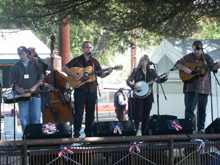
|
Parkfield & Huck Finn Bluegrass 2003 |
||
|
|
||
|
Parkfield (Camp Rude) All About Bluegrass Festivals Huck Finn Bluegrass History |
||
|
Thursday, June 12: May is the time for
one of our favorite bluegrass festivals – Parkfield is in the hills directly west of
Avenal and south of Coalinga, but access is via The week before Although most festivals run Friday through
Sunday, the astute fan arrives no later than Wednesday, to ensure a
good camping spot. During the 100 mile drive from I got set up in a fairly dry, solid spot, with
water and electricity (both are in limited supply, another reason
for arriving early). I said hi to a few people I knew from other
festivals, and got acquainted with Ted and Ida, my next door
neighbors. They have a band and play “folkgrass” in Twain
Harte,
and sing and play very well together. During that first evening they
were joined by dobro player Ivan
Rosenberg, Uncle Slosh himself, who
I visited in Thursday is exploration day, since there are no
official events. The first year we drove up the road that goes to
Coalinga. It turns to dirt as soon as it starts up from the northern
end of the valley, and goes over a pass. Area residents say “never drive on it in the winter.”
In 2002 we took the 24 mile drive to San Miguel, through rolling
hills, hay fields, and oak and pine woodland. This year, I drove
back down the Parkfield road toward Highway 46 a few miles and took some
pictures of the scenery, then went up Since Mikie is now in kindergarten, he and his mother did not come with me, but instead drove over Friday when he got out of school at 11:30. They arrived during the first group's performance, so did not miss much. The rest of the weekend was devoted to some
great bluegrass music, including performances by Another group worthy of mention is the Grateful Dudes, who play every week in a pizza parlor in southern California. The bass player and lead singer is Bill Bryson, who played with Chris Hillman in the Desert Rose Band. He was also with the popular but now defunct California bluegrass band, The Bluegrass Cardinals, plays with another southern California group, Laurel Canyon Ramblers, and performs with an outstanding three-man combo, Bluegrass Etc., with Dennis Caplinger on guitar and banjo; and John Moore on mandolin and guitar. I've seen them at two festivals and they are incredible. (2006 update: An artist that was new this year was 12-year old Frankie Nagle. As of 2006 she was playing with the northern California group Donner Mountain, who won the band contest at the Huck Finn festival that year. She has developed into a good singer and very good banjo player.) Other groups that appeared are shown below, and were mostly average. Aside from the music, we had fun watching Mikie try to catch lizards. He always brings his net and a plastic bug box and catches bugs, and he was convinced that he could also catch a lizard. I assured him they were too quick and too smart, but one thing I should know by now is that Mikie is not easily discouraged. At the end of the festival, he went home with two lizards, who are now enjoying a lazy life eating crickets in a big cage in his bedroom. June is the big month for major festivals in Both of these festivals feature some of the
biggest names in bluegrass, with some of the same artists appearing
at both events. The decision on where to go is more a matter of
whether you want to go north or south, rather than who you want to
see. This year’s festivals feature Rhonda Vincent, who is
considered the number one female artist in Bluegrass; Doyle Lawson and Quicksilver, a veteran group with many popular
CDs; award-winning Since there is a danger that I might at some
point act rude, I knew I had to avoid My route took me south on California 99 to I arrived about three and got set up in my reserved spot. The fellow next to me came over and said, “You know, my friend Cliff Warner is supposed to be in this spot.” Of course, I was exactly where the festival staff had directed me, and had a ticket with number 27 on it, so I figured Cliff was out of luck. Nevertheless, I rode my bike over to the entry station to let them know about the discrepancy. About a half hour later a guy in an orange vest appeared at my door to inform me that they had given me the wrong color confirmation sheet, and that I should be in B27, instead of A27. I finished dinner, threw everything in the truck or trailer, took the awning down, folded up the stabilizing legs, and hitched up to move. The new spot was tight and narrow, and I had to wind around the “roads” a bit and come in from a different direction so I could back into the spot, but I eventually got set up again, only moderately pissed off. As I explained to my new neighbor, I would really be mad if I had never made a mistake, but I’m pretty sure I did once. The weather here is very nice…probably about
85 with a slight breeze this afternoon, and 59 now at North of where I am now camped is a huge pasture with horses (just two spaces away). West of us is a very busy railroad track. I hope it’s not too busy during the music. One train blasted his horn for 30 seconds straight while I was trying to talk on the cell phone today. The location is Friday, June 13: The structure and format of a bluegrass festival is pretty well formalized, standardized and choreographed. There are two non-performers who are essential to the success of any festival. The Master of Ceremonies introduces the groups and talks, tells jokes and makes announcements between sets. For the last six festivals I attended, the MC has been T. J. Lyons, musician, iron worker and president of SWABA. He is friendly and outgoing, major qualifications for the job. Even more essential is the sound crew. They arrive at least one or two days before the festival, set up speakers and microphones, run cable, and hook up a huge mixing board. Their job is to make sure the performers can hear themselves and each other in proper balance through the stage monitors, and that the sound is right for the audience. Between sets they rearrange microphones and adjust levels, but the job is not done. Since volume varies, singers shift around, and microphones get bumped, they must stand ready to tweak the sound any number of times during a set. At the last six festivals I’ve attended, Old
Blue Sound of Colorado, ably headed by Art Kershaw, has handled the sound.
Although I have described these two jobs as “non-performers,” I
have seen T. J. with a group called The performances usually start right on time, and each group plays for 40 to 50 minutes. Depending on the schedule, there may be an obligatory encore for each group; or they may just end their set (at this festival, a few groups got called back for encores). Then there is a ten minute intermission, while the MC does his thing and the sound crew sets up for the next group. There are no prima donnas in bluegrass, so the group just does the sound check right there in full view…no one descends from the wings on a rope. A daily schedule may start anywhere between nine and two, with a later start normal on Friday. Saturday and Sunday start times are nearly always between nine and ten. The first few festivals I attended went on till ten at night, but a couple of them have finished up around six. This allows fans time to fix dinner and have plenty of time for picking and grinning. For some, this is the main part of the festival – the chance to get together and play with old and new friends. Those of us whose strength lies in listening are the “grinners.” At each festival there are always a few groups of people who never attend the main show; they prefer to spend the time picking. Prices are very reasonable – the Huck Finn festival was $50 for the three days, plus Thursday, Friday and Saturday night camping. Electricity is available at some events, and at this one it costs $70 extra – fairly expensive considering RV parks typically charge $18 to $25 for full hookups (water, sewer and electric). No festival offers sewer hookups, although this one is in a public campground, where you normally find a sewer dump. There are no water hookups here. At other festivals it’s been first come, first served on electrical and water hookups. The festival at Parker AZ in March had no hookups available. Of course, there are plenty of opportunities to spend more money. All festivals feature vendors, selling food, crafts, musical instruments and CDs, and various other things. In addition, most of the performing groups have CDs and tapes for sale. This event has more venders than I have ever seen, plus several portable ATMs, a climbing wall, and balloon rides. In keeping with the name, there is also a fence painting contest, raft building contest, and other events, including a Huck Finn look-alike contest. (This assumes that someone knows what Huck actually looked like.) The music is starting, so I gotta run.
9 p.m.
: Had some great music today, as well as some average and so-so
music. The best was Doyle Lawson and Quicksilver; in fact, theirs
was the best live bluegrass performance I have seen anywhere,
anytime. They are known for their outstanding harmony, but everyone
in the band is also first rate on his instrument. Doyle has been
touring for 40 years, and has had his own group, Quicksilver, since
1979. As with most bands, members come and go, and some of the
present group were not born or were very young when he started out.
They played two sets, and are heading for Also
way above average was Karl Shiflett and Big
Country, a group that is also from the east or maybe The music wrapped up about 8, and was followed by a Mark Twain impersonator (NOT Hal Holbrook). He was OK, but I did not stay to the end. One of the groups that played this morning appeared on a secondary stage last night and again tonight, and I watched them for a while both nights. I didn’t get a good night’s sleep last night, so I will read a bit and try to get to bed early. Tomorrow’s show starts at 9:30. Sunday, June 15, 2003
: The music is over, and I had a great time. The big groups
Saturday were Rhonda Vincent and Blue Highway started up about ten years ago, and I bought one of their CDs after reading about them in a bluegrass magazine. Both groups were outstanding, giving clear evidence of why they are considered at the top of their profession. I was able to get CDs by both groups autographed. Today the big event was a rare west coast appearance by the Del McCoury Band, and a closing show by country star Patty Loveless, who went “back to her roots” with an acoustic/bluegrass CD that she released a couple of years ago. She is an honest-to-goodness coal miner’s daughter and grew up listening to the Stanley Brothers, Flatt & Scruggs, and other bluegrass pioneers. Patty Loveless did the first half of her show featuring songs from the Mountain Soul CD, performed on acoustic instruments. The band then switched to electric guitars, drums, keyboards, etc. and got very loud. A number of people who had been sitting in the first ten rows or so (including myself), moved to the back to avoid hearing damage. The songs were good, just too loud up close. I have three or four of her country CDs. The most enthusiastic band at this
or any other festival was the Lampkins Family, who I also saw at I will get hitched up and head home right after breakfast tomorrow.
Wednesday June 18, 2003
: I had an uneventful trip home on Monday. I got started early,
about A Short, Mostly Accurate History of and Essay on Bluegrass Music There was a time when bluegrass was considered
just another variation of country or hill From the start, Bill Monroe established a
hard-driving, high speed sound; but it was some time before anyone
(including Bill) thought that he had created anything new or
different. The band name, The Blue Grass Boys, came from the nickname
of The band achieved its greatest acclaim when Lester Flatt (vocals and guitar) and Earl Scruggs (banjo) joined up. Earl played in a “new” style, using a three-finger picking technique rather than the more common two-finger or clawhammer method. He was not the first to use this method, but he is certainly the most acclaimed and is responsible for making it the standard in bluegrass music. Earl and Lester soon realized they could make
more money as band leaders rather than employees, and left The other group that is considered to be among the pioneers and greatest practitioners of the music, along with Monroe and Flatt & Scruggs, is the Stanley Brothers and the Clinch Mountain Boys. Of these early pathfinders, Ralph Stanley and Earl Scruggs, both around 80 years of age, continue to perform (2020 Update: Earl died in 2012 and Ralph in 2016). Many other musicians are included in the “first generation” or early “second wave” of bluegrass artists – Jimmy Martin, Don Reno & Red Smiley, the Osborne Brothers, and Jim & Jesse. The latter two groups, and others that followed, took the music in new directions (and took some heat for doing so). Even so, they are all considered quite traditional today. Over the years there have been some extreme experiments, including the long-standing New Grass Revival, and others of more recent vintage. The debate over what is “real” bluegrass music has continued for over 30 years and will probably never end. However, the typical bluegrass band generally avoids drums and electricity, and includes some combination of guitar, banjo, mandolin, bass, fiddle and dobro (AKA resonator guitar). Electric bass is fairly accepted, because of the hassle of carrying a big acoustic “doghouse” bass around, but the majority still use the stand-up. Some bass players have been using standard electric instruments, the same thing you’d see Bill Wyman or John Entwhistle play; but recently the hollow-body “acoustic-electric” bass has seen some use. This instrument looks like a large guitar and is held on a strap. One player at the Huck Finn festival had a stand-up electric bass, with the long neck, but no “box.” One bluegrass group, plus Patty Loveless (who is more country than bluegrass) had small snare drums at Huck Finn; other than this I have not seen drums of any kind used. The first time someone set up a drum kit at the Grand Ole Opry, they were nearly run out of town on a rail, but of course, drums are a standard part of today’s “modern country.” Most bluegrass fans enjoy older country music, but us “old curmudgeons” are not too happy with the direction it has taken in the last decade. Country icon Ray Price calls it “nothing but ‘70s Rock & Roll.” Give us the honky tonk sound of the 50s and 60s! Many bluegrass festivals include performers who are not exactly bluegrass, but are at least acoustic. Huck Finn featured two solo artists, one male and one female, who performed alone with only their guitar as accompaniment. Another group played music that would be defined more as “old time.” And it’s not unusual to hear groups whose leaning is more Celtic or Irish. At the Kings River Bluegrass and Country Festival (held at Hobbes Grove in Sanger each September), there is more country than bluegrass (and too much electricity in my opinion). There have always been mumblings about bluegrass performers who do “country” songs instead of “bluegrass” songs – but a study of the Flatt & Scruggs repertoire reveals many titles that are considered straight country songs today and were then. More questionable is the adaptation to bluegrass of songs by the Beatles, Bob Dylan and other such artists. Such efforts range from laughable to very successful. Flatt & Scruggs recorded a number of Dylan songs, presumably in an attempt to be more “up to date” as traditional country and bluegrass fell out of favor in the 1960s. Although the acoustic standard is maintained in 99% of what is presented as bluegrass, the overall sound is quite different from Bill Monroe or Flatt & Scruggs. Some of this is due to improved recording techniques, but most contemporary bluegrass has a much more polished sound, both vocally and instrumentally. If you’re looking for what I think are the
best groups today, go with Rhonda Vincent & the Rage, Doyle
Lawson & Quicksilver, the Country Gentlemen, --Dick Estel |
||
|
Photos (click to enlarge; photos open in a new window) |
||
| Camp Rude (Parkfield) | ||
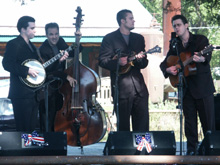 |
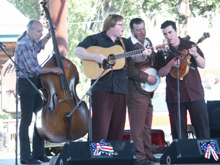 |
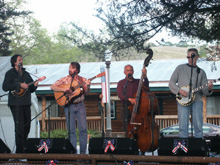 |
| The Backstreet Bobs | Cliff Wagner & the Old #7 | Grateful Dudes |
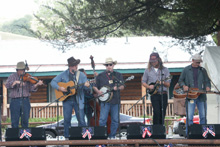 |
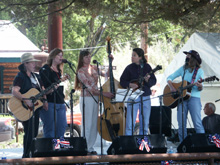 |
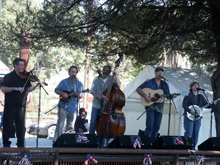 |
| Earthquake Country | Parkfield Peahens | Kane's River |
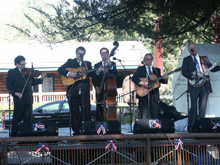 |
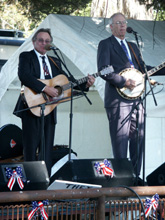 |
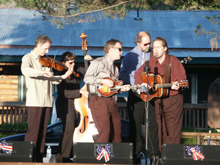 |
| Lost Highway | Ken Orrick & Dick Brown | Sam Hill |
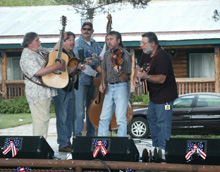 |
 |
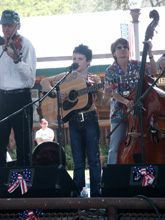 |
| Southside | Chris Stuart & Backcountry | Frankie Nagel & Friends |
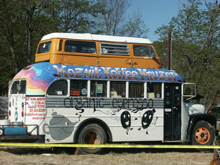 |
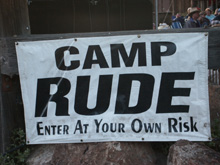 |
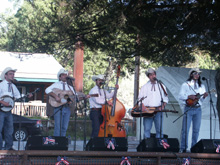 |
| Double Decker Coffee Shop | Fair Warning | Iron Lasso |
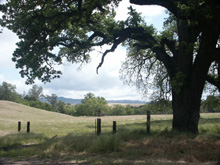 |
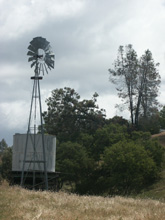 |
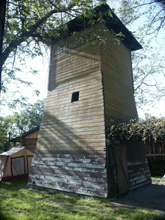 |
| Oaks and hay fields near town | Windmill by Turkey Flat Road | Old water tank in "downtown" Parkfield |
| Huck Finn Jubilee | ||
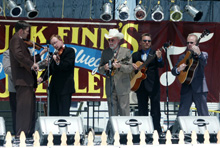 |
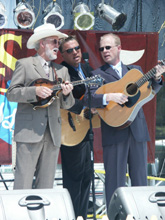 |
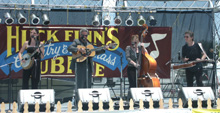 |
|
Doyle Lawson & Quicksilver |
Doyle Lawson, Barry Scott, Jamie Dailey | The Lampkins Family |
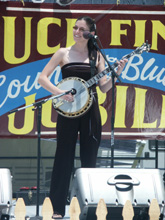 |
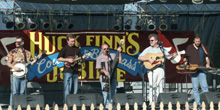 |
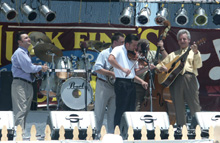 |
| Jamie Lampkins | Blue Highway | Del McCoury Band |
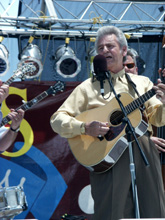 |
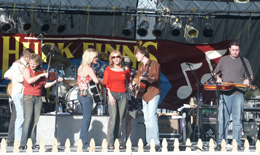 |
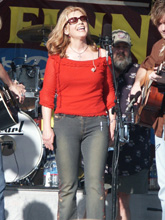 |
| Del McCoury | Patty Loveless Band | Patty Loveless |
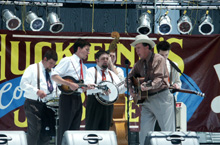 |
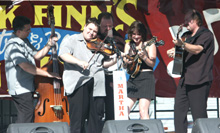 |
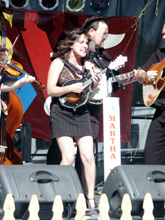 |
| Karl Shiflett & Big Country Show | Rhonda Vincent & the Rage | Rhonda Vincent |
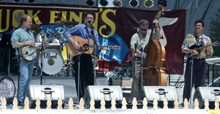 |
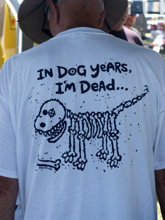 |
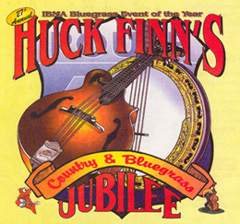 |
| Weary Hearts Reunion | Old Bluegrass Fan | Huck Finn Logo |
|
Web Sites |
||
| Blue Highway | Bluegrass Music on Amazon | Chris Stuart & Backcountry |
| Cliff Wagner & the Old #7 | Del McCoury Band | Dick's Bluegrass Links |
| Dick's Travel Reports | Doyle Lawson & Quicksilver | Grateful Dudes |
| Huck Finn Jubilee | Dick's Bluegrass T-Shirt Photos | Karl Shiflett & Big Country Show |
| Kane's River | Lampkins Family | Lost Highway |
| Patty Loveless | Rhonda Vincent & the Rage | Southwest Bluegrass Association |
| New Grass Revival | Old Blue Sound |
Mojave |

